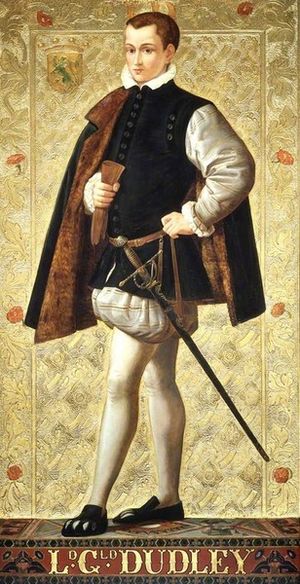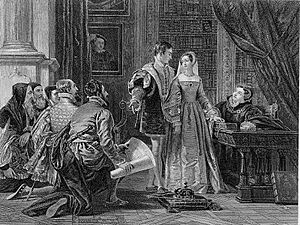Lord Guildford Dudley facts for kids
Quick facts for kids Lord Guildford Dudley |
|
|---|---|

19th-century depiction of Guildford Dudley in the Houses of Parliament, Westminster
|
|
| Consort of the English monarch (disputed) | |
| Tenure | 10 July 1553 – 19 July 1553 |
| Born | c. 1535 |
| Died | 12 February 1554 (age 18/19) Tower Hill, London, England |
| Burial | St Peter ad Vincula, London |
| Spouse | |
| Father | John Dudley, 1st Duke of Northumberland |
| Mother | Jane Guildford |
Lord Guildford Dudley (also spelled Guilford) was an English nobleman born around 1535. He is best known for being married to Lady Jane Grey. Jane was declared the heir to King Edward VI and briefly ruled England from July 10 to July 19, 1553.
Guildford Dudley received a good education, focusing on subjects like history and literature. He married Jane in a grand ceremony just weeks before King Edward VI died. After his father, the Duke of Northumberland, helped Jane become queen, Guildford and Jane lived in the Tower of London during her short reign.
When their rule ended, they remained prisoners in the Tower. They were later found guilty of a serious crime against the crown in November 1553. Although Queen Mary I initially wanted to let them live, a rebellion led by Thomas Wyatt against Mary's marriage plans changed everything. This led to the young couple's execution, which many people thought was very unfair.
Contents
Guildford Dudley's Family and Marriage
Lord Guildford Dudley was the second youngest son of John Dudley, who later became the Duke of Northumberland. His mother was Jane Guildford. The Dudley family had a long history, dating back to the 1300s. They were the lords of Dudley Castle.
Guildford's grandfather, Edmund Dudley, was an important advisor to King Henry VII. However, he was executed in 1510 after Henry VIII became king. Through his grandmother, Guildford was also related to famous heroes from the Hundred Years War.
The thirteen Dudley children grew up in a Protestant home. They all received a modern education for their time. Guildford's father became a very powerful figure under the young King Edward VI. He practically ruled England from 1550 to 1553.
A writer from that time, Richard Grafton, described Guildford as "a handsome, good, and noble gentleman." In 1552, Guildford's father tried to arrange a marriage for him with Margaret Clifford. But this plan did not work out.
Instead, in the spring of 1553, Guildford became engaged to the sixteen-year-old Lady Jane Grey. Both Jane and Margaret Clifford were great-granddaughters of King Henry VII. However, Jane was closer in line to the throne.
On May 25, 1553, three weddings took place at Durham Place, the Duke of Northumberland's home. Guildford married Jane. His sister Katherine married Henry Hastings, the heir to the Earl of Huntingdon. Jane's sister Katherine married Henry Herbert, the heir to the Earl of Pembroke.
It was a grand celebration with jousts, games, and plays. Important guests, including ambassadors from Venice and France, attended. Many common people and important nobles were also there. Guildford and some others got sick from food poisoning. This happened because a cook made a mistake with some ingredients.
Guildford's Claim to Kingship
King Edward VI, before he died, decided that Lady Jane Grey should be his heir. He skipped over his half-sisters, Mary and Elizabeth. After Edward's death on July 6, 1553, the Duke of Northumberland worked to make the King's wish happen.
Jane was not eager to become queen. She finally agreed after many nobles, including her parents and in-laws, persuaded her. Guildford also encouraged her with "prayers and loving words." On July 10, Jane and Guildford officially entered the Tower of London.
While living in the Tower, Guildford wanted to be made king. Jane later said they had a long talk about this. She told him that if he became king, it would be through her and an act of Parliament. However, Jane would only agree to make him a duke, not king. Guildford said he did not want to be a duke; he wanted to be king.
When Guildford's mother, the Duchess of Northumberland, heard about the argument, she became very angry. She told Guildford he could not sleep with his wife anymore. She also ordered him to leave the Tower and go home. But Jane insisted that he stay at court by her side.
Some foreign ambassadors later said that Guildford led the daily meetings of the King's Council. They also claimed he ate alone in a royal manner and was addressed as a king. The French ambassador, Antoine de Noailles, even called him "the new King." The Imperial court in Brussels also believed that King Guildford existed.
Imprisonment in the Tower
On July 10, the same day Jane was declared queen, a letter arrived from Mary Tudor. She stated that she was now queen and demanded the Council's loyalty. Mary was gathering her supporters in East Anglia. It was decided that troops would go to fight her. Jane made sure her own father would not go.
The Duke of Northumberland marched to Cambridge with his soldiers. After a week with no fighting, he heard on July 20 that the Council in London had declared for Mary. Northumberland himself announced Mary Tudor as queen in the marketplace. He was arrested the next morning.
On July 19, just hours before Queen Mary I was proclaimed in London, a baby was baptized. Jane had agreed to be the godmother. She wanted the child to be named Guildford. Stephen Gardiner, a bishop who had been imprisoned in the Tower for five years, was very offended when he heard this.
Most of the Privy Council left the Tower before changing their loyalty to Mary. Jane's father, the Duke of Suffolk, realized what was happening. He gave up his command of the fortress and proclaimed Mary I on nearby Tower Hill. After he left, his wife was told she could go home. However, Jane, Guildford, and the Duchess of Northumberland were not allowed to leave.
Jane was later moved from the royal apartments to the jailer's rooms. Guildford was imprisoned in the Bell Tower. His brother, Robert Dudley, soon joined him there. His other brothers were held in different towers. His father was the only important person to be executed at that time. Mary was willing to spare Jane's and Guildford's lives.
Jane and Guildford were formally accused of crimes on August 12. Jane sent a letter to the Queen, asking for forgiveness. She explained what had happened and spoke of herself as "a wife who loves her husband." On November 13, 1553, Jane and Guildford were put on trial at Guildhall. Archbishop Thomas Cranmer and Guildford's brothers Ambrose Dudley and Henry were also tried.
They all pleaded guilty and were found guilty of a serious crime against the crown. Guildford was found guilty of trying to remove Queen Mary I from power. This included sending troops to his father and declaring Jane as queen.
In December, Jane was allowed to walk freely in the Queen's Garden. Lord Robert and Lord Guildford could only get fresh air on the roof of the Bell Tower. Jane and Guildford might have had some contact. At one point, Guildford wrote a message to his father-in-law in Jane's prayer book: Your loving and obedient son wishes unto your grace long life in this world with as much joy and comfort as ever I wish to myself, and in the world to come joy everlasting. Your humble son to his death, G. Dudley
Guildford's Execution
Queen Mary I's plan to marry Philip II of Spain was not popular. Many people, including members of Parliament, were against it. Thomas Wyatt's rebellion in early 1554 happened because of this dislike. The rebels did not intend to put Jane Grey back on the throne.
However, during this difficult time, around February 7, the government decided to execute Jane and her husband. They had both been found guilty of a serious crime against the crown. This was also a chance to remove any possible reasons for future trouble. It was hard for Mary to let her cousin die, but she accepted the advice of her council. Bishop Gardiner pushed for the young couple's execution. The Imperial ambassador, Simon Renard, was glad to report that "Jane of Suffolk and her husband are to lose their heads."
The day before their executions, Guildford asked Jane for a last meeting, but she refused. Around ten o'clock in the morning on February 12, Guildford was led to Tower Hill. Many gentlemen were waiting to shake his hand. Guildford gave a short speech to the crowd, as was the custom. He was buried in the chapel with Jane, who died within the hour.
These executions did not make Mary or her government more popular. Five months after their deaths, John Knox, a famous Scottish religious reformer, wrote that they were "innocents." He said that by fair laws, they could never be proven to have done wrong themselves. Ten years later, the writer Grafton wrote about Guildford: "even those that never before the time of his execution saw him, did with lamentable tears bewail his death."
See also
 In Spanish: Guilford Dudley para niños
In Spanish: Guilford Dudley para niños
- Cultural depictions of Lady Jane Grey



